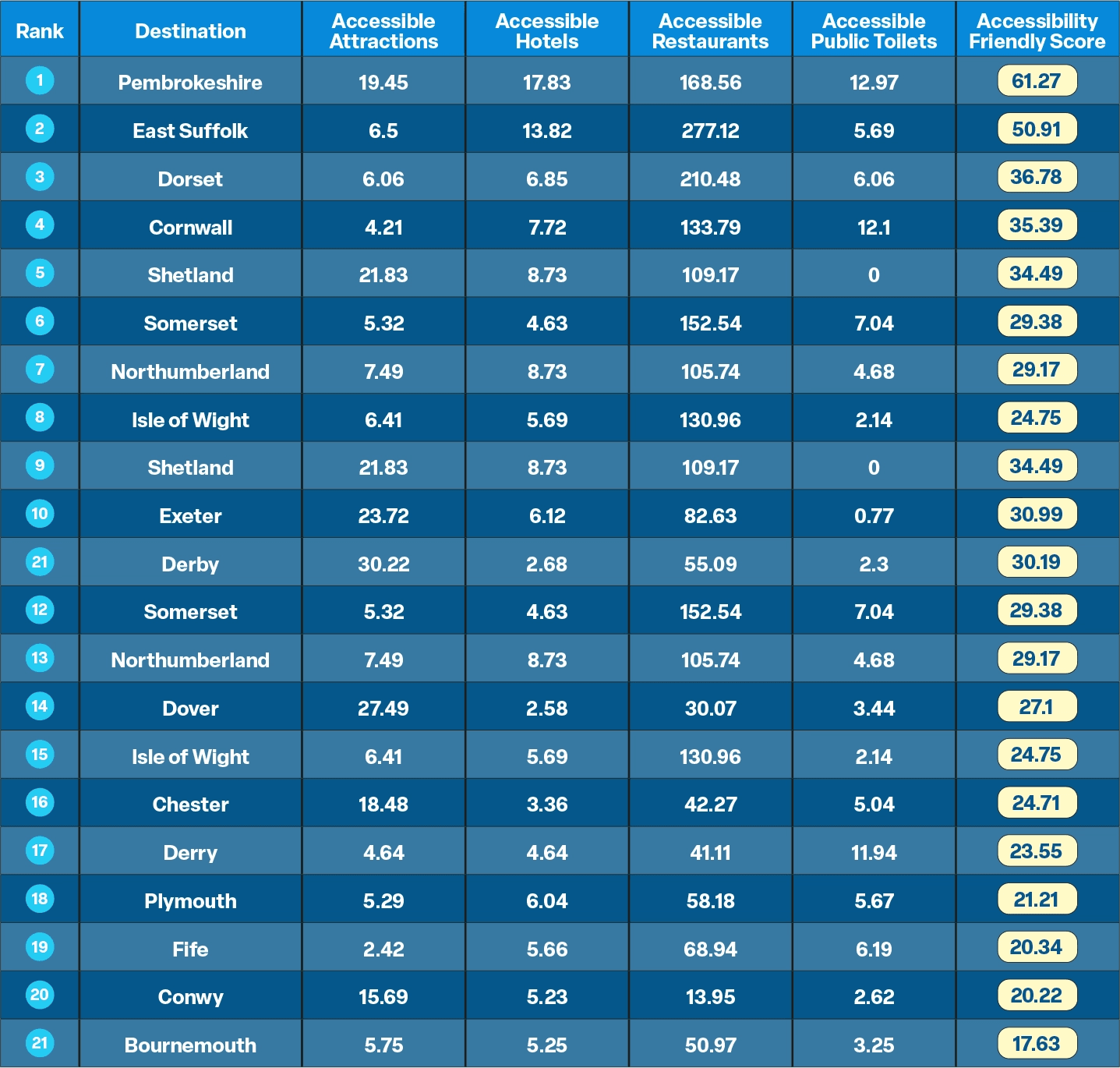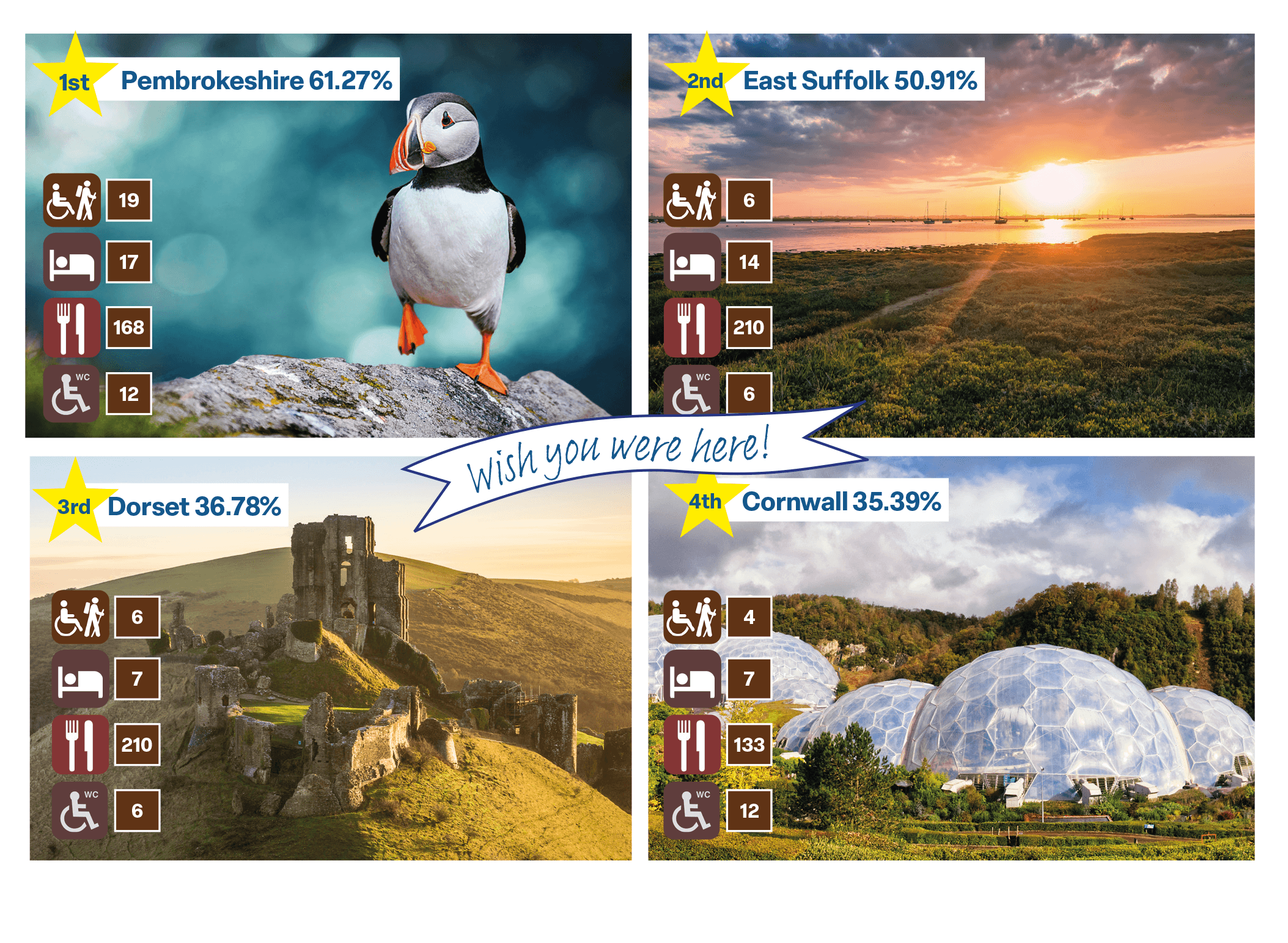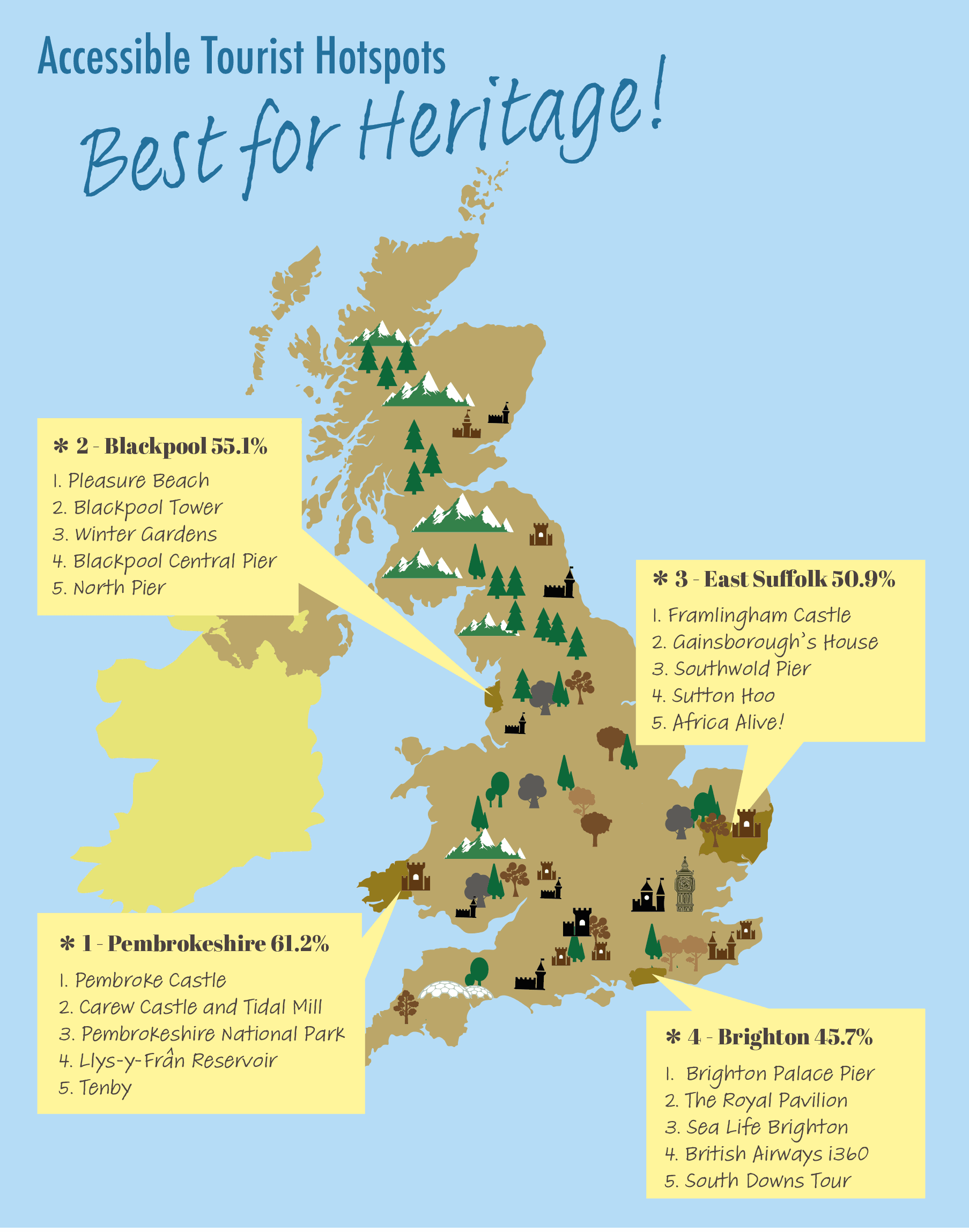As the travel industry continues to progress it’s clear that accessibility has become more than just a consideration – it’s a necessity. With an ageing population and an increasing demand for more inclusive experiences, destinations across the country are rising to the challenge of making tourism more accessible for all. From scenic coastal towns to historical cities, accessible travel isn’t just about compliance. It’s about creating inclusive environments where everyone can enjoy the wonders of the UK without barriers.
We’ve analysed key destinations across the UK to uncover which of our favourite tourist hotspots are best for meeting accessibility needs, based on the availability of accessible attractions, hotels, restaurants, and public facilities; giving us a comprehensive view of where inclusivity truly thrives.
In this post, you can discover which destinations are setting the standards for accessibility, and why making tourism more inclusive benefits everyone, not just those with mobility challenges.
The Most Accessible UK Tourist Hotspots

For people with accessibility challenges, travelling can often present a unique set of obstacles that go beyond the typical considerations of destination and activities.
“One of the most important aspects of accessibility is the physical access to spaces – whether it’s hotels, restaurants, or attractions being equipped with ramps, elevators, and wide doorways to accommodate wheelchairs and mobility aids,” says Daniel Stone, Director at TGA Mobility. “But it’s not just about physical access. Clear signage, accessible public toilets, and well-maintained paths are equally crucial in making a location truly inclusive for everyone.”
For many, travel isn’t just a luxury. It’s a source of independence and empowerment, allowing us to enjoy new experiences and connect with the world around them without unnecessary limitations. Creating inclusive, barrier-free environments ensures that everyone, regardless of physical ability, can enjoy the freedom and joy of travel.
These were the top ranking destinations for accessible-friendliness:
Pembrokeshire: 61.27/100
Pembrokeshire tops the list with an impressive score, boasting a wealth of accessible attractions set against the backdrop of the stunning Welsh coastline. Some key highlights include the famous Pembrokeshire Coast National Park, which offers several accessible trails, including the popular Skrinkle Haven, where wheelchair users can enjoy the coastline’s beauty. Attractions such as Pembroke Castle and Carew Castle have also been praised for their accessible facilities, with ramps, lifts, and disabled parking.
Also situated in the county is Folly Farm, a family friendly and inclusive attraction with farm animals, a zoo, and some vintage fairground rides. “This is a venue that has really put some thought into its accessibility to ensure guests with disabilities feel as comfortable and as safe as possible,” says one user on Euan’s Guide.
Blackpool: 55.13/100
Coming in second is a firm Brit favourite. With attractions like the Blackpool Tower and the Pleasure Beach, both equipped with ramps, accessible seating, and assistance services, Blackpool ensures that everyone can join in on the fun.
The Tower itself has been praised for its inclusivity, with many reviewers on Euan’s Guide commenting on the “great view from the accessible area, and it has a lovely dedicated staff member. Lots of flat space, and chairs available for family/carers so we could sit together.”
The famous Blackpool Illuminations have designated viewing areas for wheelchair users, allowing everyone to experience this spectacular event. Speaking about the attraction, Alex, from The Life Quadriplegic said “I went on the rocket tram which was a good way to see all the lights. It had a lift for wheelchairs to get up into the carriage which was great considering it was an old tram.”
Cambridge City: 53.94/100
Cambridge stands out for its accessible attractions, which blend historic charm with modern accessibility. The city’s renowned Fitzwilliam Museum, and Cambridge University Botanic Garden, both offer wheelchair-friendly pathways and facilities. One user commented on the accessibility of the garden, via Euan’s Guide: “everything is perfect no matter what is required. Great paths, plenty of seats, good food, knowledgeable, interesting and helpful staff.”
The city’s compact size also makes it easy to navigate, with accessible buses and plenty of step-free routes through its historic streets.
East Suffolk: 50.91/100
East Suffolk ranks 4th with the highest number of accessible restaurants per capita, making it a top choice for foodies with accessibility needs. From the scenic coastal town of Aldeburgh to the Sutton Hoo archaeological site, East Suffolk offers a range of accessible attractions that allow visitors to experience its rich history and culture.
Speaking about Sutton Hoo, a frequent reviewer of Euan’s Guide spoke of the “kind, helpful and accommodating staff. No disablist behaviours especially towards the neuro diverse, learning disabled and/or those with learning difficulties.”
The Suffolk Coast & Heaths Area of Outstanding Natural Beauty (AONB) also features accessible walking paths, perfect for exploring the natural landscapes.
Brighton: 44.57/100
Brighton performs well when it comes to providing accessible public facilities, especially along its famous seafront. Brighton Palace Pier and the Royal Pavilion both offer accessible entrances, and the city’s beaches feature dedicated wheelchair ramps, along with beach wheelchairs available for hire. Brighton is also home to numerous accessible shops, cafes, and restaurants, making it a highly inclusive city.
One reviewer spoke of the “excellent level access” to the beach’s boardwalk which “enables wheelchair users and anyone with mobility problems to get along the beach to the marina. I walk with 2 poles and was able to make my way to an area with benches.”
The Worst Tourist Destinations for Accessibility
When places aren’t accessible, it impacts more than just people with disabilities. It can affect anyone, including families with strollers, older visitors, and even those recovering from injuries. A lack of simple amenities such as ramps, elevators, or clear pathways, can lead to frustration and discomfort, and in some cases, cause people to change their plans entirely.
Daniel explains, “When destinations fail to prioritise accessibility, they are missing out on a significant portion of the market. Making spaces accessible isn’t just about helping people with disabilities. It’s about creating environments that work for everyone. Inclusivity ensures that all visitors, regardless of mobility, can fully enjoy their experience and feel welcome.”
Ultimately, when accessibility isn’t a priority, it can hurt both visitors and local businesses, making the destination less appealing for a wide range of travellers.
These were the lowest ranking hotspots:
Bournemouth: 17.63/100
While Bournemouth ranks lowest on the accessibility scale, it still offers a welcoming seaside experience for many visitors. The city has made efforts to improve, with accessible beach wheelchairs now available for hire and future plans to enhance the available public facilities. There’s a clear opportunity to invest in more accessible infrastructure here, like additional ramps and clear pathways, to make the experience even more inclusive for families, elderly visitors, and people with mobility challenges.
Conwy: 20.22/100
Conwy, with its historic charm, is already a popular destination for those seeking a mix of culture and nature. While accessibility may not be its strongest point, the town has great potential to improve its infrastructure, especially around its key attractions like Conwy Castle. Enhancing pathways and providing more accessible options could make this picturesque town more welcoming to a broader audience.
Fife: 20.34/100
Fife is known for its scenic coastal paths and natural beauty, which already draw in nature lovers. While its accessibility ranking is lower, Fife has the potential to improve by making its stunning landscapes more accessible to everyone. Simple additions, such as accessible viewpoints and enhanced pathways along the Fife Coastal Path, could ensure that everyone, regardless of mobility, can enjoy the area’s breathtaking views.
Plymouth: 21.21/100
Plymouth is a city steeped in history, with attractions like the Mayflower Steps and the National Marine Aquarium. Although accessibility could be improved, particularly in public facilities and transportation options, Plymouth could invest in more accessible infrastructure around its historical sites. This way the city can ensure all visitors, including those with mobility challenges, can engage fully with its rich maritime heritage.
Top Nature-Packed Retreats

The UK’s top nature retreats offer not only breathtaking views but also essential opportunities for relaxation and healing. These destinations, with their accessible trails and peaceful surroundings, provide a much-needed escape from the stresses of everyday life.
According to Daniel, nature plays a crucial role in mental well-being, particularly for individuals living with long-term health conditions: “Spending time in nature has been shown to reduce anxiety, improve mood, and promote a sense of calm,” she explains. “For those managing chronic illnesses or mobility challenges, nature provides a unique form of therapy, allowing people to reconnect with themselves and the world around them for both mental and physical relief.”
Below are some of the UK’s top accessible nature retreats, offering both beauty and accessibility:
Pembrokeshire
Scoring 61.27/100, Pembrokeshire is renowned for its beautiful coastal National Park, offering 19.45 accessible attractions per capita. This region is celebrated for its dramatic cliffs, sandy beaches, and wildlife, with accessible coastal paths making it easy for all visitors to take in the breathtaking scenery. If you’re keen on spotting local wildlife, take a trip to Skomer Island aboard their accessible boats to see native Puffins.
East Suffolk
East Suffolk scored 50.91/100, and is home to the Suffolk Coast and Heaths AONB. The area sported 6.50 accessible attractions per capita, and is known for its unspoiled coastlines and nature reserves, such as RSPB Minsmere, where accessible trails allow visitors to enjoy nature’s tranquillity with a spot of bird watching!
Dorset
Dorset, with a score of 36.78/100, is famous for its Jurassic Coast, a UNESCO World Heritage Site. With 6.06 accessible attractions per capita, Dorset’s accessible walks at Durdle Door and Lulworth Cove offer everyone the chance to enjoy its stunning coastline.
Cornwall
This scenic seaside destination scored 35.39/100. Known for its rugged coastlines and picturesque beaches, the region offers 4.21 accessible attractions per capita, including parts of the South West Coast Path; home to stunning coastal views. Visitors can explore accessible sections of Tintagel Castle, blending nature and history for a unique and inclusive experience.
Best for Heritage
The UK is rich in cultural and historical heritage, polka dotted with destinations that tell the story of our past and identity. It’s crucial that these heritage sites are inclusive, ensuring that all visitors, regardless of mobility needs, can explore and connect with these important landmarks.
Below are some of the top destinations for heritage lovers, combining rich history with accessibility.

Pembrokeshire
Pembrokeshire, scoring 61.27/100, is home to mediaeval treasures like Pembroke Castle and Carew Castle, making it a key heritage destination. With 19.45 accessible attractions per capita, this region allows visitors to explore its castles and coastline with ease, providing a seamless blend of history and natural beauty.
Blackpool
Second on our list is Blackpool, which is not only a popular seaside resort but a symbol of Britain’s leisure heritage. The Victorian-era Tower and its famous promenade are accessible for all, and the destination has 23.40 accessible attractions per capita. Blackpool’s blend of history and entertainment offers something for everyone, making it one of the most inclusive heritage spots.
East Suffolk
East Suffolk scores 50.91/100 overall for accessibility, and is known for Sutton Hoo, an ancient Anglo-Saxon burial site. With 6.50 accessible attractions per capita and an abundance of heritage towns like Aldeburgh, this region offers visitors the chance to explore both its coastal and cultural history. Accessible facilities around Sutton Hoo ensure that everyone can learn about its archaeological significance.
Brighton
With a score of 45.77/100, Brighton combines its Royal Pavilion, a former royal residence, with Victorian seaside charm. Visitors can enjoy 11.55 accessible attractions per capita, including the Pavilion’s unique architecture and the lively Brighton Palace Pier, which ensures that Brighton’s rich cultural history is available to all.
Portsmouth
Portsmouth, scoring 45.07/100, is a must-visit for anyone interested in the UK’s naval heritage. The city is home to the Portsmouth Historic Dockyard, which includes the HMS Victory and the Mary Rose Museum, offering 28.85 accessible attractions per capita. These historic ships and museums have been adapted for accessibility, making Portsmouth’s naval history open for everyone to enjoy!
Additional Insights
Could a lack of accessible tourism be damaging the economy?
Accessibility isn’t just about doing the right thing. It’s good for business. Destinations like Brighton and Portsmouth are seeing the benefits of being more inclusive by attracting a wider range of visitors, including families with strollers and perhaps elderly tourists. When places are easy for everyone to navigate, more people visit, which means more money spent in local shops, restaurants, and hotels.
“Making tourism more accessible isn’t just about helping people with disabilities,” says Daniel. “It’s about opening doors for everyone! Whether it’s individuals with significant mobility issues or older people who need a little extra help. When you make things accessible, you’re inviting more people to enjoy what your destination has to offer, which benefits the entire local economy.”
On the flip side, inaccessible destinations are losing out on potential visitors. Whether it’s people with long term health conditions, or those recovering from injuries; people will choose a staycation that’s easier to navigate. East Suffolk and Dorset are great examples of areas that are improving accessibility for everyone, making their regions more welcoming for all types of travellers.
Accessibility of UK’s Hotels is a Challenge
While many UK tourist hotspots have made great strides in public space accessibility, there’s still a significant gap when it comes to the availability of accessible hotels. In places like Blackpool, Brighton, and Pembrokeshire, all of which scored relatively highly overall; wheelchair-accessible hotels still only make up 2.82% to 4.72% of available accommodations.
“Visitors need somewhere comfortable to stay that can meet their needs,” says Daniel. “Accessible hotels are key to making sure everyone can enjoy their trip, and right now, there’s a real gap in what’s available. Destinations need to step up to meet this demand.”
If more hotels focused on making their rooms and facilities accessible, it would open the doors to a wider range of visitors, helping these areas remain competitive in the tourism market.
Public Toilet Accessibility is a Major Concern
For many tourists, the availability of accessible public toilets can make or break their experience. Brighton is leading the way with 65.20% of its public toilets being accessible, but other tourist spots like Cornwall (22.90%), Dorset (18.30%), and Blackpool (16.70%) are lagging behind.
“Something as simple as access to an accessible toilet can make a big difference to a visitor’s experience,” says Daniel. “It’s a basic need that, when overlooked, can exclude many people from enjoying a destination fully. Improving this is a win-win. It’s a small investment with a big impact!”
Improving public toilet accessibility is an easy step that can undoubtedly improve the visitor experience for individuals with mobility issues. It’s clear to us that investing in these facilities will help make UK destinations more welcoming and inclusive for all.
Conclusion
Accessibility is essential in today’s travel industry, benefiting not only those with mobility challenges but also families, the elderly, and more. UK tourist destinations like Pembrokeshire and East Suffolk are leading the way, offering inclusive experiences that allow everyone to enjoy nature, culture, and heritage without barriers.
While many hotspots are making progress, there’s still room for improvement, particularly in pathways and accessible facilities, an accommodation specifically requires attention.
Daniel Stone, Director at TGA Mobility, shared their thoughts on the findings:
“When destinations lack accessibility, individuals with mobility challenges are excluded from experiences that should be available to everyone. It’s not just about missing out on market opportunities – it’s about people missing out on the chance to explore and connect with beautiful places across the UK. Inclusivity means creating environments where everyone feels welcome and valued, allowing all visitors to make the most of their travels without limitations.”
To ensure the UK remains a leader in cultural tourism, inclusivity must continue to be a priority, creating travel experiences that welcome everyone.
Methodology
The most accessible UK tourist destinations were measured using a weighted rank, with equal weightings on the following metrics:
1: Number of attractions that are classed as wheelchair accessible according to https://visitrevisit.co.uk/
2: Number of hotels that are classed as wheelchair accessible according to https://www.booking.com/index.en-gb.html
3: Number of restaurants that are classed as wheelchair accessible according to https://www.tripadvisor.co.uk
4: Number of public toilets that are classed as accessible according to https://www.toiletmap.org.uk/
The final “Accessibility Friendly” Ranking is based on a score of 0-100. The ranking score for each individual metric is based on the number of accessible options per capita. Per capita is calculated by taking the number of accessible options per 100,000 people that live in that destination according to the 2021 Census Survey.
The 21 tourist destinations were chosen via desk research analysis of popular UK tourist destination lists.
Data is correct as of October 2024.
